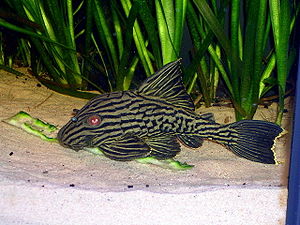Black line harness catfish
| Black line harness catfish | ||||||||||||
|---|---|---|---|---|---|---|---|---|---|---|---|---|

Panaque nigrolineatus |
||||||||||||
| Systematics | ||||||||||||
|
||||||||||||
| Scientific name | ||||||||||||
| Panaque nigrolineatus | ||||||||||||
| ( Peters , 1877) |
The black line catfish ( Panaque nigrolineatus ) is a freshwater fish from South America.
What aquarists use this name often refers to other species, some of which have only recently been scientifically described. The animals listed under the designation L 27 among aquarists belong to Panaque armbrusteri Lujan, Hidalgo, and Stewart 2010. The species belonging to other lines (L 190, L 191) or "Royal Panaque" is z. T. unclear.
The Panaque nigrolineatus has a peculiar rhombic body shape and a conspicuous gray-black drawing. Since its scientific description in 1889, other species of the Panaque nigrolineatus have been discovered that differ from the L27 in various body features (for example the color of the eyes, the color of the stripes or the achievable body length). The suckling catfish is native to South America, mainly in Venezuela and Brazil, and is used to temperatures around 28 ° C. When fully grown it reaches a height of over 40 cm; individual animals are said to have grown up to 80 cm at times. Nothing is known exactly about the life expectancy of the Panaque nigrolineatus; it should be several decades. The black line armor catfish feeds mainly on wood and plants.
Aquaristics
With its attractive drawing and its peculiar body shape, the Panaque nigrolineatus is one of the most popular aquarium catfish. In captivity, the fish can reach a size of over 30 cm, which is why keeping in aquariums below 300 l is not advisable.
The L27 is easy to socialize with other ornamental fish and prefers water temperatures around 28 ° C. Sometimes he reacts aggressively to same-sex conspecifics. Several black line armored catfish should therefore only be kept in a sufficiently large tank with numerous hiding spots.
Since the Panaque nigrolineatus needs a lot of wood to maintain its digestive function, sufficient moorland roots should be available in the aquarium , which also offer the nocturnal catfish shelter and shade during the lighting phases. The Panaque nigrolineatus also likes to accept raw potatoes, cucumbers or peas and, if there are enough vegetables, leaves the aquarium plants alone.
In the opinion of many aquarists, the Panaque nigrolineatus should not be bred in captivity. In individual cases, however, the breeding should have been successful.
